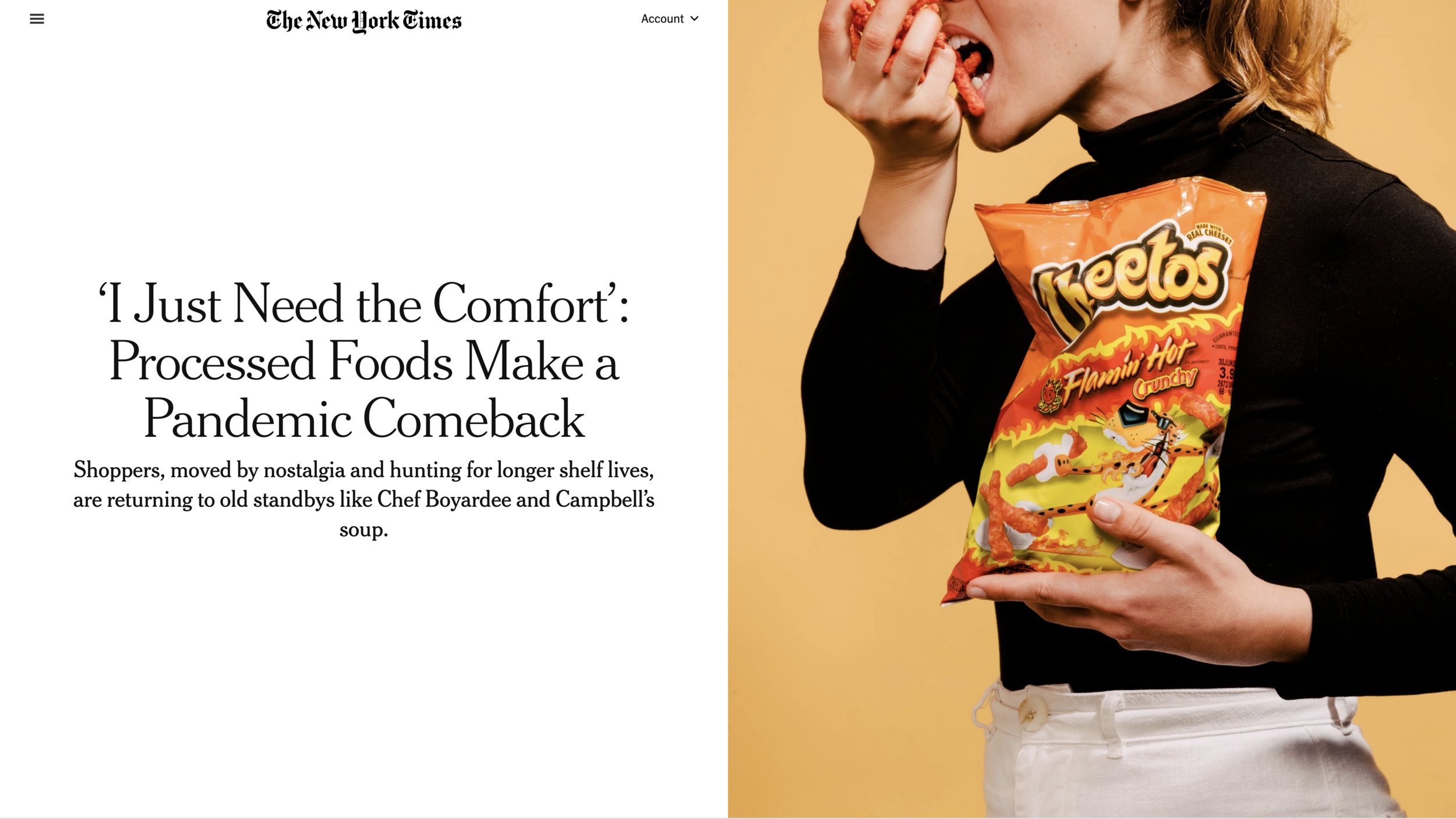Interactions between COVID-19 and Chronic Diseases
With all the attention on COVID-19, it is important to remember that chronic diseases such as diabetes and heart disease and other diseases affected by diet and exercise such as cancer and strokes lop off many more total human years of life than COVID-19 is every likely to. While sheltering at home from the coronavirus, it is dangerous to increase consumption of processed food if there is any way at all to avoid doing so. According to Julie Creswell’s April 17, 2020 New York Times article “‘I Just Need the Comfort’: Processed Foods Make a Pandemic Comeback,” many people are doing just that. However, people are eating less restaurant food, which means the net effect on healthfulness of food eaten is unclear: it depends on how unhealthy restaurant food is compared to processed food from the grocery story. Julie writes:
As the coronavirus shutdowns continue across the United States, two growing trends involving how people eat — the rising amount of money spent on meals outside the home and the increased purchase of fresh or organic foods in grocery stores — have been reversed. Many restaurants have closed, and shoppers are reaching for frozen pizza and boxes of cereal instead of organic greens and whole grains.
I write about why processed food is a problem in “The Problem with Processed Food.”
I can report that my wife and I are still able to get plenty of produce even from the limited range of things available for pickup from the local grocery store, though we have had to substitute heads of cabbage that we chop up in place of the spinach we would usually buy, for example.
In addition to bad health consequences 10, 20, 30 or 40 years in the future, the chronic diseases to which bad diet contributes so much are taking a toll now when people get the coronavirus. In her April 12, 2020 Wall Street Journal article “Heart Conditions Prove Especially Dangerous for Covid-19 Patients,” Betsy McKay writes:
People with cardiovascular disease face more life-threatening complications and a substantially higher risk of death from the new coronavirus …
Among the complications are conditions that put these patients’ already strained hearts under additional stress. While Covid-19 is a respiratory disease, doctors increasingly report that some patients develop cardiovascular complications such as heart-rhythm disorders, blood clots and inflammation causing chest pain that mimics a heart attack.
…
Cardiovascular disease is the most common and deadliest so far of several underlying conditions that make some people more vulnerable to the ravages of Covid-19, a disease that causes barely an ache or pain for some who are infected but sends others to ICUs for weeks. People with diabetes, chronic lung disease and cancer are also at risk, according to several studies.
…
The mortality rate of Covid-19 patients who have cardiovascular disease is more than four times higher than the rate for patients overall with the illness, according to data from the Chinese Center for Disease Control and Prevention. It is nearly three times higher for Covid-19 patients with high blood pressure alone, the Chinese agency found.
Nearly two-thirds of Covid-19 patients who died in intensive care in Lombardy, Italy, had hypertension, according to a study of 1,591 cases in JAMA Cardiology. Nearly half of U.S. hospitalized Covid-19 patients in a study by the U.S. Centers for Disease Control and Prevention had hypertension, and 27.8% had cardiovascular disease.
I added bold italics to one sentence in the middle of this passage to emphasize the other chronic diseases and diseases affected by diet and exercise that also make COVID-19 more dangerous besides the heart disease advertised in the headline of the article.
One of the mysteries of COVID-19 is why children are endangered by at as little as they are. Influenza has a different pattern of being deadliest for the very young as well as the very old. Interactions with chronic diseases and diseases fostered by a lifetime of bad diet could be part of the explanation: young children have these chronic diseases at a much lower rate than old folks. Sumathi Reddy’s March 10, 2020 Wall Street Journal article “How Vulnerable Are Children to the New Coronavirus?” does point to two other speculative explanations:
… some experts speculate that children may not have the same density of the receptors to the virus that adults have. There has also been speculation that children may have more protection due to exposure to other coronaviruses. But Vanessa Raabe, an infectious disease specialist at NYU Langone Health, says there’s not enough data to say that’s the case.
You might think that it is already to late to affect your danger from COVID-19 if you have a chronic disease except by reducing your chance of getting the virus. But if diabetes is a risk factor, I’ll bet prediabetes—which a large fraction of Americans have, whether they realize it or not—is also a risk factor. And I’ll also bet that if you go off sugar for the next three weeks you can materially reduce any prediabetes that you have. On tips to help with doing that, see:
There is a lot more to still figure out about the interactions between chronic diseases and COVID-19, but what evidence we have suggests that by changing your diet—and hopefully also increasing your exercise—to fight chronic diseases, you can make yourself tougher in relation to COVID-19. And remember that COVID-19 is far from the only health danger that you face. Just because deaths from chronic diseases are better spread out doesn’t mean they are pleasant deaths. And all of us who are lucky enough to have those who love us cause grief to those who love us when we die, whatever disease we die from.
For annotated links to other posts on diet and health, see:

